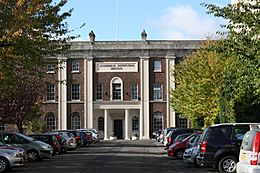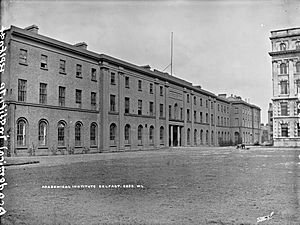Royal Belfast Academical Institution facts for kids
Quick facts for kids Royal Belfast Academical Institution |
|
|---|---|
 |
|
| Address | |
|
College Square East
, , BT1 6DL
|
|
| Coordinates | 54°35′49″N 05°56′11″W / 54.59694°N 5.93639°W |
| Information | |
| Type | Voluntary grammar school |
| Motto | Quaerere Verum (To Seek the Truth) |
| Established | 1810 |
| Founder | William Drennan |
| Chairman of the board of governors | Colin Gowdy |
| Principal | J. Williamson |
| Age | 11 to 18 |
| Number of students | 1060 (approx.) |
| Houses | Dill Jones Kelvin Larmor Pirrie Stevenson |
| Colour(s) | Black and gold |
| Newspaper | Sea Horse |
| Yearbook | School News |
| Affiliations | Inchmarlo Prep. |
| Former pupils | Instonians |
| Website | http://rbai.org.uk/ |
The Royal Belfast Academical Institution is a well-known school in Belfast, Northern Ireland. People often call it Inst. It's a grammar school for boys aged 11 to 18. The school first opened its doors in 1814. It was started with help from important people in Belfast who wanted to make education available to more students.
For a while, until 1849, Inst also offered college-level education. This was a new idea for Belfast at the time. The school is located on a large 18-acre site right in the middle of the city.
Contents
School History
How Inst Began
The idea for Inst came from William Drennan in the early 1800s. He wanted to create a new kind of school. Drennan believed that education should be easier to get and less expensive for everyone. He also wanted to make sure that both boys and girls could learn. This was quite a modern idea for the time!
Many important people in Belfast supported Drennan's plan. They wanted to offer classes in science, languages, and literature. They even hoped to train ministers for the Presbyterian Church. In 1810, the school officially received its charter. This meant it was allowed to open.
The school's foundation stone was laid in 1810. A famous architect named John Soane helped design the buildings for free. Money was raised from many people, including wealthy merchants in Belfast. The school officially opened on February 1, 1814.
Drennan promised that the school would be open to students of all religions. He also said that fees would be kept low. And, very importantly for the time, he wanted discipline to be based on good examples, not on physical punishment. This was a new way of thinking about how to teach children.
Early College Days
In 1815, Inst became the first place in the British Isles to offer university-level courses since Trinity College Dublin was founded centuries earlier. This part of the school was called the collegiate department.
However, the school soon faced challenges. Some people in the government worried that Inst was too "democratic." They thought it might encourage ideas that went against the government. Despite these worries, the school continued to grow. In 1831, King William IV even gave the school the title "Royal."
Inst also had a medical school starting in 1835. It was the first medical school in Ulster. It even had its own teaching hospital. This was very important for the region. The school buildings themselves were used as a fever hospital during a serious typhus outbreak in 1847.
The college part of Inst closed in 1849 when Queen's College Belfast opened. Inst then continued as a school just for boys.
Famous Students and Growth
Many students from Inst went on to do great things. Some became involved in politics, fighting for things like tenants' rights. Others became newspaper editors or even the first Catholic Lord Chancellor of Ireland.
In the mid-1800s, many of Belfast's leaders in business and professions had studied at Inst. The school played a big role in the city's growth. For example, William Pirrie and Alexander Carlisle left Inst at age 15 to work at the famous Harland and Wolff shipyard. They helped design huge ships like the Olympic and the Titanic. Thomas Andrews, another Instonian, was also involved in the Titanic's design and went down with the ship in 1912.
Inst students also served in the British Empire and in wars. Over 700 former students served in World War I, and 132 of them died.
The School Today
For a long time, Inst didn't have one main headmaster. Instead, a group of senior teachers ran the school. The first official principal was appointed in 1898. Today, the principal is J. A. Williamson, who became the first female to hold the post in 2007.
Since 1902, Inst has been a day school, meaning students don't live there. However, it does have a preparatory school called Inchmarlo for younger boys.
During the Second World War, 106 former Instonians died. The school also had to adapt, with younger students attending branch schools and air-raid shelters being built on site. Even during the difficult times of the Troubles in Belfast, the school never closed for a single day due to the conflict.
In recent years, Inst has added many new facilities. These include sports centers, a sixth form center, and a new hockey pitch. Today, RBAI has over 1,000 students on its main site and over 200 at Inchmarlo.
What Students Learn
For the first three years, boys at Inst follow a common set of subjects. In the fourth year, they start to choose some options. At the end of the fifth year, they take their Northern Ireland GCSE exams.
In the sixth form (the final two years), students study subjects at AS/A2 level. These include English, history, geography, economics, French, German, Spanish, math, physics, chemistry, biology, music, and art.
School Houses
Students at Inst are part of different "houses." These houses compete against each other in sports and other activities.
| House | House colour |
|---|---|
| Jones | Yellow |
| Kelvin | Green |
| Larmor | White |
| Pirrie | Blue |
| Stevenson | Brown |
| Dill | Red |
Sports and Activities
Inst offers many clubs and societies. These include a school orchestra, choir, and band. There are also Scouts and a community service group.
Sports at Inst
Sports are a big part of life at Inst. Rugby union is especially popular. The school has won the Ulster Schools Cup many times. Rugby and hockey are played in winter. In summer, students play athletics, cricket, and tennis. Other sports like badminton, fencing, rowing, squash, and swimming are played all year round.
Inst teams compete not just in Northern Ireland but also in events across the United Kingdom. In 2016, four former Inst students played Olympic hockey! The school is also one of only four in Northern Ireland to have a competitive rowing team.
The swimming teams compete in Ireland and abroad. In 2005, three swimmers qualified for the Irish International Schools Squad. The water polo teams also travel for competitions. Football is also played with three senior teams.
Music and Arts
Students can join various musical groups, including the choir, orchestra, jazz band, and string group.
Scouting at Inst
The school sponsors the 74th Belfast (RBAI) Scout Group, which started in 1926. Many former scouts from Inst have achieved great things, including becoming Chief Commissioner for Northern Ireland. The group has a long history of activities, including summer camps and trips abroad.
During World War II, many former scouts served in the armed forces. A memorial was built to remember those who died. The scout group also takes part in the Duke of Edinburgh's Award Scheme, which helps young people develop skills and serve their community. In recent years, the group has traveled to places like Canada, Mozambique, and Argentina to help build homes for people in need.
Debating Society
Inst has a very old debating society called the Royal Academical Debating Society. It helps students learn to speak confidently and argue their points clearly. The society holds competitions within the school and also competes against other schools.
Inst teams have won the Northern Ireland Schools Debating Championship twice. They also compete in European debating competitions, representing Northern Ireland in events across Europe.
Inchmarlo Preparatory School
The Royal Belfast Academical Institution has a preparatory school for younger boys called Inchmarlo. It was founded in 1907 and is located on a 6-acre site in South Belfast.
Inchmarlo teaches boys aged 4 to 11. Their uniform includes traditional school caps, shorts, knee-high socks, and blazers. The school helps students prepare for the 'Eleven-plus' exam, and most of them achieve high grades. About 99% of Inchmarlo students then move on to the main Inst school each year.
Famous Former Students
Many people who went to Inst have become famous in different fields. Here are just a few:
- Science:
* Thomas Andrews (chemist and physicist) * William Thomson, Lord Kelvin (famous physicist, the school's Kelvin house is named after him) * Sir Joseph Larmor (mathematician, the school's Larmor house is named after him)
- Arts and Literature:
* Michael Longley (poet) * Derek Mahon (poet) * Paul Henry (landscape painter)
- Business and Industry:
* Thomas Andrews (chief naval architect for the Titanic) * William Pirrie, Viscount Pirrie (chairman of Harland and Wolff, Pirrie House is named after him) * Paul Rankin (television chef)
- Government and Politics:
* J. M. Andrews (second Prime Minister of Northern Ireland) * Brian Mawhinney (former UK Member of Parliament and Cabinet minister) * Lembit Öpik (former UK Member of Parliament)
- Law:
* Lord Carswell of Killeen (former Lord Chief Justice of Northern Ireland) * Lord Thomas O'Hagan (first Roman Catholic Lord Chancellor of Ireland)
- Media:
* Stephen Nolan (BBC radio and television presenter) * Jim Neilly (BBC sports commentator)
- Medicine:
* Sir Ian Fraser (famous surgeon)
- Military:
* Colonel Tim Collins (British Army officer) * Brigadier John Alexander Sinton (doctor and recipient of the Victoria Cross)
- Religion:
* Robert Rayond Davey (Presbyterian minister and peace activist)
- Sport:
* Keith Crossan (Irish rugby international) * Mark Gleghorne (Irish and Great Britain hockey international, Olympian) * John Jackson (Irish hockey captain and Olympian) * Sammy Nelson (former Arsenal and Northern Ireland footballer) * Dawson Stelfox (first Northern Irishman to climb Mount Everest)
|


